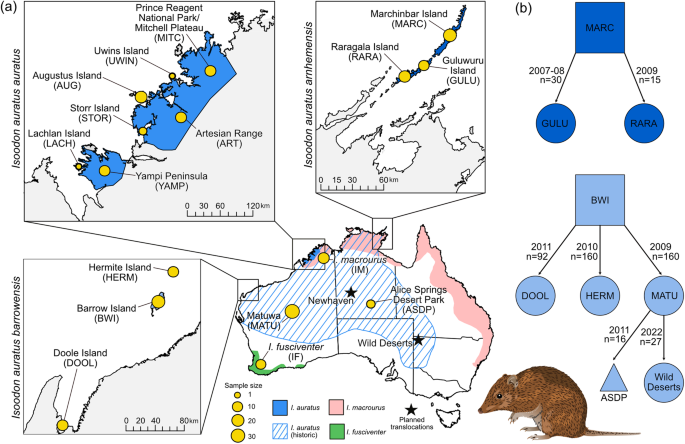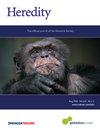Population genomic diversity and structure in the golden bandicoot: a history of isolation, extirpation, and conservation
IF 3.9
2区 生物学
Q2 ECOLOGY
引用次数: 0
Abstract
Using genetic information to develop and implement conservation programs is vital for maintaining biodiversity and ecosystem resilience. Evaluation of the genetic variability within and among remnant populations can inform management of both natural and translocated populations to maximise species’ adaptive potential, mitigate negative impacts of inbreeding, and subsequently minimise risk of extinction. Here we use reduced representation sequencing to undertake a genetic assessment of the golden bandicoot (Isoodon auratus), a threatened marsupial endemic to Australia. The currently recognised taxon consists of three subspecies distributed among multiple natural and translocated populations. After confirming the genetic distinctiveness of I. auratus from two closely related taxa, I. fusciventer and I. macrourus, we identified four genetic clusters within I. auratus. These clusters exhibited substantial genetic differentiation (pairwise FST values ranging from 0.18 to 0.65, pairwise DXY ranging from 0.1 to 0.168), reflecting long-term isolation of some populations on offshore islands and the influence of genetic drift. Mainland natural populations in the Kimberley region had the highest genetic diversity and the largest contribution to overall allelic and gene diversity compared to both natural and translocated island populations. A population translocated to Guluwuru Island in the Northern Territory had the lowest genetic diversity. Our data suggest that island populations can appear genetically unique due to genetic drift and this needs to be taken into account when considering genetic diversity in conservation efforts to maintain overall genetic diversity of the species. We effectively demonstrate how genomic information can guide practical conservation planning, especially when declining species are represented by multiple isolated populations.


金斑蝶种群基因组多样性和结构:分离、灭绝和保护的历史。
利用遗传信息制定和实施保护计划对于保持生物多样性和生态系统的复原力至关重要。评估残余种群内部和之间的遗传变异性可以为自然种群和迁移种群的管理提供信息,以最大限度地提高物种的适应潜力,减轻近亲繁殖的负面影响,并随后将灭绝风险降至最低。在这里,我们使用减少代表性测序对澳大利亚特有的濒危有袋动物金带鱼(Isoodon auratus)进行了基因评估。目前公认的分类单元由三个亚种组成,分布在多个自然种群和迁移种群中。在从两个亲缘关系密切的分类群,即灰尾锦鸡和大尾锦鸡中确认了锦鸡的遗传独特性后,我们在锦鸡中鉴定了四个遗传簇。这些集群表现出显著的遗传分化(成对的FST值在0.18到0.65之间,成对的DXY在0.1到0.168之间),反映了近海岛屿上一些种群的长期隔离和遗传漂移的影响。与自然和异地岛屿种群相比,金伯利地区的大陆自然种群具有最高的遗传多样性,对总体等位基因和基因多样性的贡献最大。迁移到北领地古鲁武鲁岛的种群遗传多样性最低。我们的数据表明,由于基因漂移,岛屿种群可能表现出遗传上的独特性,在保护工作中考虑遗传多样性以保持物种的整体遗传多样性时,需要考虑到这一点。我们有效地展示了基因组信息如何指导实际的保护规划,特别是当数量减少的物种由多个孤立的种群代表时。
本文章由计算机程序翻译,如有差异,请以英文原文为准。
求助全文
约1分钟内获得全文
求助全文
来源期刊

Heredity
生物-进化生物学
CiteScore
7.50
自引率
2.60%
发文量
84
审稿时长
4-8 weeks
期刊介绍:
Heredity is the official journal of the Genetics Society. It covers a broad range of topics within the field of genetics and therefore papers must address conceptual or applied issues of interest to the journal''s wide readership
 求助内容:
求助内容: 应助结果提醒方式:
应助结果提醒方式:


